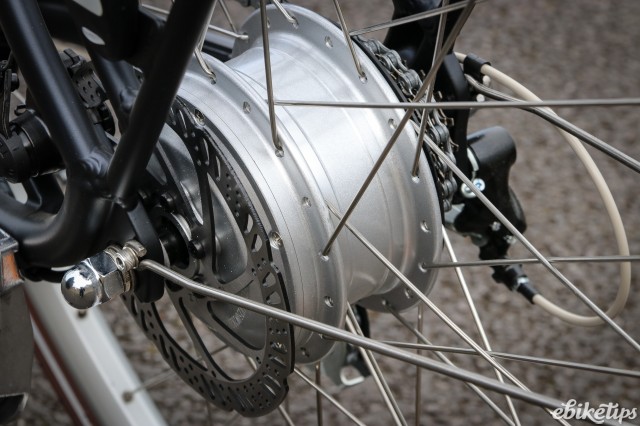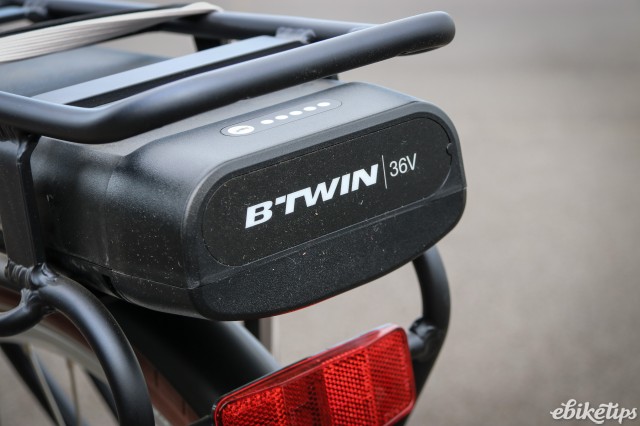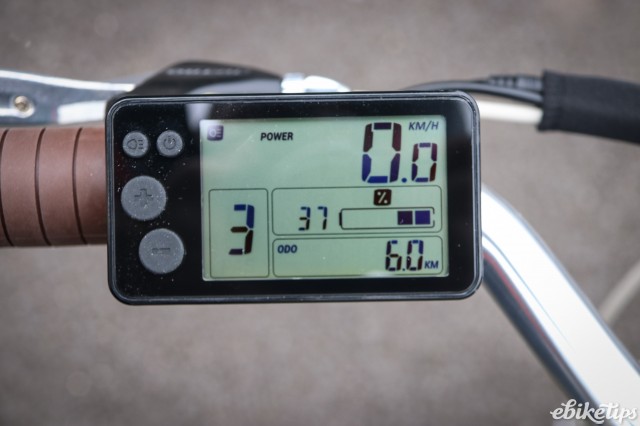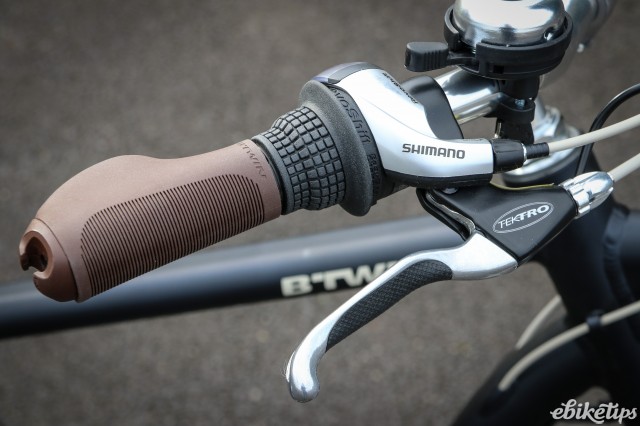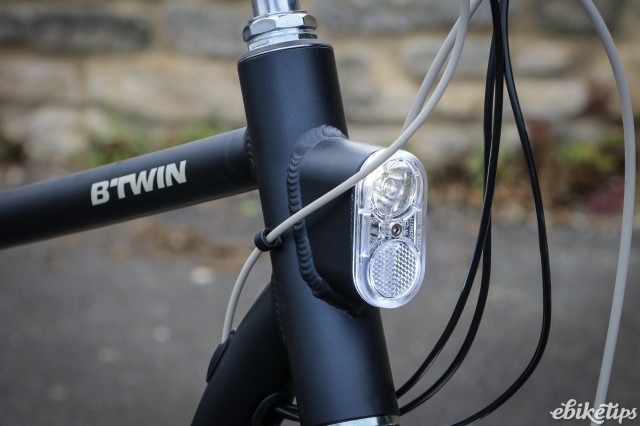ebiketips
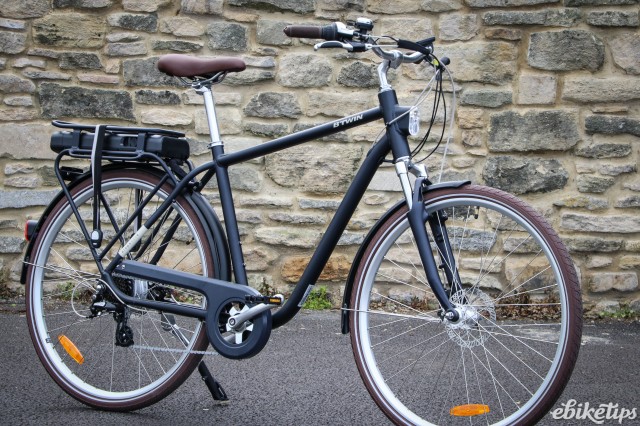
The B’Twin Elops 900e is a decent e-bike that’ll get you around with a minimum of fuss. At £999 it’s keenly priced, as we’d expect from a company with the buying power of Decathlon. Available in diamond frame and step-through configurations, the Elops 900e has everything you need for city riding. It doesn’t have the most powerful motor though, so it’s not the best choice for hilly terrain.
The Elops has been part of B’Twin’s city range for a while, with bikes starting at just £199 for the Elops 500. The electric bikes use the same basic frame design and add electrical assistance; the steel-framed £649 Elops 500e and this bike use a hub motor setup (the cheaper bike uses a 24V system, with a 36V motor used here) and the £1,799 Elops 940e uses the more powerful Shimano STEPS mid motor system.
So this is the middle of the B’Twin range, with a lighter weight frame and a higher-spec motor system. At £999 it’s not expensive, and that’s borne out in the spec used here. You get a Shimano Altus 7-speed drivetrain, mechanical disc brakes and a cheap non-adjustable suspension fork. The motor is in the rear hub, with a 418Wh battery located in the rear rack. The bar-mounted LCD gives you access to three levels of assistance (plus a walk function) and also functions as a basic bike computer. Lights are built in, with the front light in the head tube and the rear in the mudguard.
The motor: a good system, if a little underpowered
The rear hub motor is a fine companion on the flat, with the three assistance modes well spread. The B’Twin firmware has the lower assistance modes dipping out at lower speeds; it’s not an approach that I’d choose but I can understand the logic behind it, with less assistance for slower, more sedate journeys. For me, though, it just meant that I had it on full gas the whole time, as I don’t really want to bimble around at 19km/h. To be fair, it isn’t that unusual for me to just stay in turbo mode…
It’s not the most powerful motor, and it’s fair to say it struggled on my commute which includes a 1.5km hill at an average of 5%, with the steepest section at 12%. Getting round the steep corner required quite a bit of effort in bottom gear, so if your riding is going to take in steep climbs on a regular basis it’s probably not going to be a perfect match. In terms of power it’s rated at 30Nm and it’s similar to other cheaper hub-powered bikes I’ve tried, but it’s not quite as powerful as some units available on bikes around this price point, such as the TranzX F-15 hub that you can find on bikes from the likes of EBCO. Climbing on the bike isn’t helped by the fact that the bike is a little bit overgeared, with gears that are much better for flat cruising than they are for going uphill. The 7-speed cassette doesn’t give a massive range; the bike could do with a smaller chainring.
It’s a tale of two cities for me: when I went out to try the bike originally on the flat streets of Lille, Decathlon’s home town, I really enjoyed riding around on the Elops. Back on home turf in Bath I found it less fun. It’s very dependent on the topography not being too taxing.
Range is pretty good. B’Twin suggest you’ll get between 40km and 70km out of the bike, and you’ll probably be somewhere in between those two numbers if you’re riding somewhere reasonably flat. Even on my vertiginous commute I was managing three days of riding before the battery needed attention. That’s only about 25km, but that’s in line with similar bikes. One thing to note is that the Elops is pretty slow to charge: you really need to charge it overnight or over a full work day. That’s not a problem if you always remember; I don’t always remember so I had to slog it up half the hill home once without any juice. It’s not really a bike you want to riding up a hill without assistance, although it’s okay on the flat.
The ride: sensible city position, decent component choices (mostly)
The bike is pretty pleasant to ride. The frame puts you in a fairly upright position and the swept bars give good control. The tyres are fairly cheap but they’re not bad for that, with enough grip and comfort for broken roads and even the odd unsurfaced trail. The mechanical disc brakes aren’t the best I’ve tried but they’re perfectly capable and they work pretty well in all conditions. Shifting from the Shimano 7-speed drivetrain is slick, even though this is fairly low-budget gear. It’s a pretty easy bike to ride.
The built in lights are pretty good, too. You might think that the front light, which is fixed to the frame and not the bars, might spend a lot of time pointing in the wrong direction but in reality that’s not the case; it’s rare that there isn’t light where you need it, and the light is powerful enough to cope with a bit of dark lane riding if your commute takes you past the street lights. The fact that it’s built in means there’s never any need to adjust it, which is handy so long as it’s pointing in the right place. Which it is.
Cheaper city e-bikes tend to have suspension forks, and those suspension forks tend to be average at best. This one is no exception: it’s clunky and not very well damped, and doesn’t have much lateral stiffness so it can feel a bit vague, especially if you’re trying to brake and steer at the same time. As usual, the upright position means that not much of your weight is over the front of the bike, and as usual the bike would probably be better off with a rigid fork.
Overall: good for flatter city trips
So who’s the Elops 900e for? Well, if you live somewhere like Cambridge it’d be an ideal city runaround. The motor makes for easy progress, and the bike is well-specced for year round use. If you’re in Lincoln or Bristol you might find the motor doesn’t really have enough oomph for bigger city climbs, and you’ll run out of gears too. That doesn’t make it a bad bike, it just limits its appeal a bit. There are more powerful bikes than this for similar money, or at least not much more, but the Elops 900e is good value and pleasant to ride, and if it suits your local terrain it’s a solid buy.
